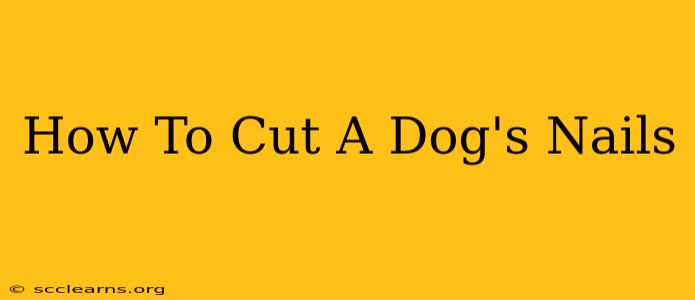Clipping your dog's nails might seem daunting, but with the right technique and a little patience, it can become a routine part of dog ownership. Regular nail trims are crucial for your dog's comfort and health, preventing painful overgrowth and potential joint problems. This comprehensive guide will walk you through the process, ensuring a safe and successful nail trim for your furry friend.
Preparing for the Nail Trim
Before you even reach for the clippers, preparation is key. A stressed dog is more likely to struggle, making the process difficult and potentially dangerous.
Gather Your Supplies:
- Appropriate Nail Clippers: Choose clippers specifically designed for dogs. Guillotine-style clippers or scissor-style clippers are both popular choices. Select the type you are most comfortable using.
- Styptic Powder (optional but highly recommended): This powder helps stop bleeding quickly if you accidentally cut the quick (the pink part of the nail containing blood vessels and nerves).
- Treats: High-value treats are essential for positive reinforcement. Use small, easily-eaten treats to reward calm behavior.
- Towel (optional): A towel can help restrain a particularly squirmy dog, but always prioritize a gentle and calm approach.
Getting Your Dog Ready:
- Choose the Right Time: Select a time when your dog is relaxed and calm. Avoid trimming nails when your dog is overly excited or stressed.
- Introduce the Clippers: Before the actual trimming, let your dog sniff and investigate the clippers. Positive association is crucial. Reward them with treats for calm behavior around the clippers.
- Get Comfortable: Ensure you have a comfortable and well-lit space to work in. Your dog should feel secure and safe.
Trimming Your Dog's Nails: A Step-by-Step Approach
Now that you're prepared, let's get to the actual nail trimming. Remember, patience is key!
1. Locate the Quick:
The quick is the pink part of the nail containing nerves and blood vessels. Cutting into the quick is painful and will cause bleeding. In dark nails, the quick is harder to see, so start by trimming small amounts at a time.
2. Hold the Paw:
Gently but firmly hold your dog's paw. Avoid squeezing too tightly, as this can cause discomfort.
3. Trim the Nail:
-
Guillotine Clippers: Insert the nail into the guillotine clipper, ensuring the entire nail is within the blade. Squeeze the handles firmly and cleanly cut the nail.
-
Scissor Clippers: Hold the clipper at a 45-degree angle and cut the nail just below the quick. Aim for small, even trims to avoid cutting into the quick.
4. Reward Your Dog:
Immediately reward your dog with praise and a treat after each successful nail clip. Positive reinforcement is key to a positive experience for both you and your dog.
Handling Difficult Dogs
Some dogs are more resistant to nail trimming than others. If your dog is particularly challenging, consider these tips:
-
Desensitization: Gradually acclimate your dog to nail trimming through positive reinforcement. Start by simply touching their paws, then progressing to handling the clippers near their paws before actually trimming.
-
Professional Grooming: If you're unable to trim your dog's nails yourself, consider taking them to a professional groomer.
Maintaining Your Dog's Nails
Regular nail trimming is essential for your dog's health and well-being. How often you need to trim will depend on your dog's breed, activity level, and how quickly their nails grow. As a general rule, aim to trim your dog's nails every 2-4 weeks or as needed.
Remember that preventing overgrown nails is much easier than correcting a serious problem. With consistent, gentle nail trimming and positive reinforcement, this essential task will become less stressful for both you and your furry friend. By taking your time and following these steps, you'll be providing your dog with the best possible care.

